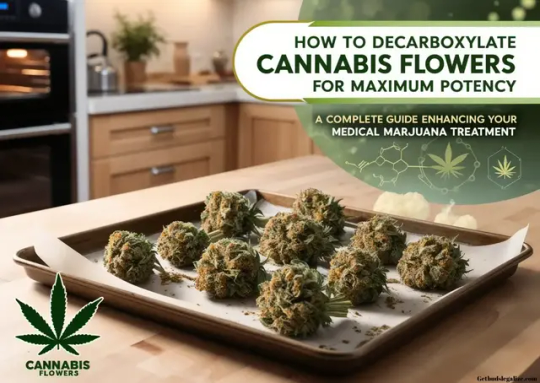#cannabisforedibles
Explore tagged Tumblr posts
Text
How to Decarboxylate Cannabis for Maximum Potency: The Ultimate Guide



How to Decarboxylate Cannabis Flowers for Maximum Potency: A Complete Guide to Enhancing Your Medical Marijuana Treatment
Decarboxylation is a vital process in cannabis preparation, unlocking the full therapeutic and recreational potential of cannabinoids like THC and CBD. Without decarboxylation, the cannabinoids present in cannabis remain in their acidic, non-psychoactive form (THC-A and CBD-A), which means you won’t experience their full benefits. Whether you’re making edibles, oils, or tinctures, decarboxylating your cannabis ensures that it’s activated for maximum effectiveness.In this comprehensive guide, we’ll walk you through the science, importance, and best methods for decarboxylating cannabis at home, ensuring you can harness the full power of your cannabis plants.
What Is Decarboxylation? Understanding the Science Behind Cannabis Activation
Decarboxylation is the process that activates the therapeutic properties of cannabis by converting its raw, inactive compounds—THC-A and CBD-A—into their active forms: THC and CBD. The chemical reaction happens through heat, which removes a carboxyl group (COOH) from the acid form of cannabinoids, thus "activating" them and enabling their bioavailability in the body.Raw cannabis flowers contain a significant amount of THC-A (tetrahydrocannabinolic acid) and CBD-A (cannabidiolic acid), which are not as effective as their decarboxylated counterparts when it comes to providing therapeutic and psychoactive effects. Through the decarboxylation process, these acids transform into THC, the compound responsible for the euphoric and psychoactive effects, and CBD, which is known for its medicinal and non-psychoactive benefits.
Why Decarboxylating Cannabis Is Essential for Edibles, Oils, and Tinctures
When preparing cannabis-infused products such as edibles, oils, or tinctures, skipping the decarboxylation process means you won’t unlock the full potential of the cannabinoids. For instance, THC-A, while abundant in raw cannabis, does not offer the same psychoactive effects as THC. By decarboxylating cannabis before infusing it into products like cannabutter or oils, you ensure that the cannabinoids are in their active forms, allowing your body to absorb and process them effectively.Without decarboxylation, you may find that your edibles, oils, and tinctures fail to produce the desired effects, leaving you with products that are either too weak or not effective at all. This is especially important for those using cannabis for medical purposes, where precise dosage and effectiveness are key to the treatment plan.
The Decarboxylation Process: How Heat Activates THC and CBD
During decarboxylation, cannabis undergoes a chemical reaction where heat removes a carboxyl group from THC-A and CBD-A. This process transforms these compounds into their bioactive forms—THC and CBD.To properly decarboxylate cannabis, it's important to apply heat in a controlled manner to avoid degrading the cannabinoids and terpenes. Terpenes are the aromatic compounds that contribute to cannabis flavor and effects, making precise temperature control essential for maintaining their integrity.Here’s a breakdown of the steps involved in decarboxylating cannabis:- Heat Application: Applying heat causes the decarboxylation process to begin. This heat can be applied in various ways, but it’s critical to maintain an optimal temperature range to ensure effective activation without burning the plant material. - Conversion: THC-A transforms into THC, and CBD-A converts into CBD. These active cannabinoids are now ready to provide therapeutic or psychoactive effects. - Effectiveness: Decarboxylation is all about balance. Too much heat can destroy cannabinoids, while too little will leave them in their inactive state. The goal is to find the sweet spot for maximum effectiveness.


Best Methods for Decarboxylating Cannabis at Home
There are several methods available for decarboxylating cannabis at home, but the oven and hot-water bath methods are among the most popular and reliable. Both methods are simple, cost-effective, and can be done in the comfort of your own kitchen.Here’s a detailed step-by-step guide for each: Oven Method: How to Decarboxylate Cannabis in the OvenThe oven method is a popular and accessible technique for decarboxylating cannabis. It’s quick, reliable, and perfect for beginners or seasoned enthusiasts looking to activate their plant material effectively. Here’s a step-by-step guide:Step 1: Preheat the OvenSet your oven to 235°F (120°C). This temperature strikes the perfect balance, activating cannabinoids without the risk of burning your cannabis.Step 2: Prepare the CannabisBreak your cannabis buds into smaller, even-sized pieces. This ensures uniform heating during the process. Spread the pieces in a single layer on a baking sheet lined with parchment paper or aluminum foil to prevent sticking.Step 3: Bake the CannabisPlace the tray in the preheated oven and bake for 40–60 minutes. Check periodically to make sure the cannabis doesn’t burn. Properly decarboxylated cannabis will turn a golden brown color and feel dry to the touch when finished.Step 4: Let It CoolOnce baking is complete, remove the tray from the oven and let the cannabis cool for at least 30 minutes. Cooling helps preserve the cannabinoids and makes the material easier to handle. Afterward, your cannabis is ready for use in recipes or infusions.This straightforward method ensures you’ll get the most out of your cannabis, unlocking its full potential for edibles, tinctures, or oils.

The Hot-Water Bath Method: A Gentle and Effective Way to Decarboxylate CannabisThe hot-water bath method is a slower, gentler approach that helps preserve delicate terpenes and cannabinoids for a more nuanced cannabis experience.Step 1: Boil WaterBring a pot of water to a boil on the stove. Ensure you have enough water to fully submerge your cannabis container.Step 2: Prepare the CannabisPlace your cannabis in a vacuum-sealed bag or mason jar. This protects the cannabis from direct contact with water, which can degrade its potency.Step 3: Heat the CannabisSubmerge the sealed bag or jar in the boiling water. Maintain a steady temperature of 220°F (104°C) for 90 minutes. Use a thermometer to monitor the water and ensure consistent heat for optimal decarboxylation.Step 4: Cool and UseAfter 90 minutes, carefully remove the bag or jar from the water. Allow it to cool completely before opening. Your decarboxylated cannabis is now ready to be used in recipes, oils, or other infusions.
The Importance of Temperature Control for Effective Decarboxylation
Maintaining the correct temperature during decarboxylation is crucial. Too much heat can destroy valuable cannabinoids and terpenes, while too little heat may result in incomplete decarboxylation, reducing potency.The ideal temperature range for decarboxylation is between 220°F and 240°F (104°C-116°C). Staying within this range ensures that your cannabis is activated properly without degrading essential compounds.


Decarboxylation Temperature Chart: Find the Perfect Heat for Your CannabisCannabinoidDecarboxylation TemperatureOptimal TimeTHC-A220°F (104°C)40-60 minutesCBD-A230°F (110°C)40-60 minutesCBG-A230°F (110°C)45-60 minutes
Why You Should Decarboxylate CBD Strains for Full Effect
While CBD strains do not have the same psychoactive effects as THC, decarboxylation is still essential to activate CBD for its medicinal properties. By decarboxylating CBD-A into CBD, you increase its bioavailability, allowing your body to absorb it more effectively.This makes decarboxylation particularly important for patients using CBD for medical purposes such as pain relief, anxiety reduction, and inflammation.
Common Mistakes to Avoid When Decarboxylating Cannabis
To ensure that your decarboxylation process is as effective as possible, be mindful of these common mistakes:- Overheating Cannabis: Exceeding temperatures of 250°F (121°C) can burn cannabinoids and terpenes, resulting in a loss of potency and flavor. Always stay within the optimal temperature range to avoid this. - Underbaking: Not allowing your cannabis to decarboxylate long enough will leave cannabinoids in their inactive acid forms, reducing their effectiveness. Make sure to monitor the process and bake for the full recommended time. - Not Monitoring the Process: Check on your cannabis regularly while it’s decarboxylating to ensure even heat distribution. Stir the cannabis occasionally to ensure it heats uniformly and doesn’t burn in some spots.
Final Thoughts: Unlocking the Full Potential of Cannabis
Decarboxylation is a simple yet vital process that allows you to fully unlock the therapeutic and recreational benefits of cannabis. By using the correct temperature and method, you can preserve the potency and flavor of your cannabis, ensuring that your homemade cannabis edibles, oils, and tinctures are as effective as possible.Whether you choose the oven method or the hot-water bath method, decarboxylation is a step you won’t want to skip.Experiment with these techniques and enjoy the enhanced effects of your cannabis-infused products!
Frequently Asked Questions (FAQs) About Decarboxylating Cannabis
What is Decarboxylation and Why is it Important for Cannabis? Decarboxylation is a key process in activating the cannabinoids in cannabis, such as THC and CBD, by applying heat to convert them into their active, psychoactive, and medicinal forms. Read the full article
#bestdecarboxylationmethod#cannabisactivationprocess#cannabisdecarboxylation#cannabisediblespotency#cannabisforedibles#cannabisformedicaluse#cannabisoil#cannabisoildecarboxylation#cannabispotency#Cannabisrecipes#cannabistherapeuticeffects#cannabistinctures#CBDactivation#CBDpotency#CBD-AtoCBD#decarbingcannabisathome#decarboxylatingcannabis#decarboxylatingcannabisflowers#decarboxylatingcannabisleaves#decarboxylationguide#decarboxylationmethods#decarboxylationtemperature#decarboxylationtips#heatandcannabiscannabinoids#homemadecannabisedibles#hotwaterbathdecarboxylation#howtodecarboxylatecannabis#ovendecarboxylation#THCactivation#THCpotency
0 notes